Latest Development and Research Direction Differences in Patent Technologies for Cyclo Olefin Copolymer Leading Enterprises Between China and Japan
Cyclic olefin copolymers (COC/COP) are amorphous, transparent polymeric materials with a cyclic structure. They possess high transparency and low birefringence, along with excellent heat resistance, chemical resistance, dimensional stability, and biocompatibility. These materials find widespread application in optical materials, medical packaging, food packaging, and electronic materials.
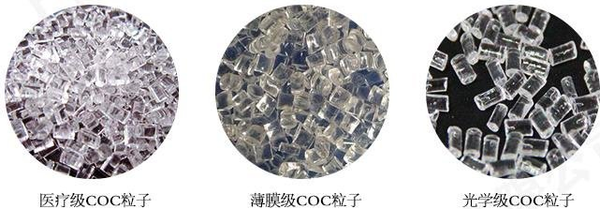
The commonly used methods for synthesizing COP/COC mainly include two approaches. One involves the Diels-Alder reaction between cyclopentadiene, dicyclopentadiene, and ethylene to produce norbornene, which is then polymerized using metallocene catalysts to generate cyclic olefin copolymers (COC). The other approach involves the ring-opening polymerization of norbornene to produce COP. In recent years, with continuous technological advancements, significant progress has been made in the research and production of COP/COC. Major enterprises have invested substantial funds, driving performance improvements and expanding application areas through technological innovation and industrial upgrading.
Major global producers of COP/COC include Japan's Zeon, Polymethyl Corporation, Mitsui Chemicals, and Synthetic Rubber Company. As of December 2023, Zeon's COP/COC capacity reached 42,000 tons per annum (t/a), while Polymethyl Corporation's capacity was 30,000 t/a; other companies have relatively smaller capacities.
Currently, the industrialization of COP/COC in China is still in its early stages, with domestic demand primarily relying on imports. At the end of 2022, the Ministry of Industry and Information Technology and the National Medical Products Administration jointly issued a notice titled "Notice on Organizing and Carrying Out the Bio-Medical Materials Innovation Task Challenge (First Batch)," which listed COP/COC as one of the bio-medical materials innovation tasks for the challenge. By analyzing the patent technologies of representative companies such as Japan's Zeon, Polyplastics, and domestic companies like Akeeli and Tuoxian Technology, it was found that improving process conditions, particularly by enhancing catalyst structures to boost conversion efficiency, is both a难点 and a key focus for enterprise research and development. Additionally, further developing new types of COP/COC products is also a critical direction for corporate innovation.
Japan Sui'en
In recent years, Japan's Zeon Corporation has continuously laid out patent protections in the COP field, covering production processes, catalyst preparation, product structure improvements, and applications among other aspects. Patent WO2018/17396 discloses various improved ring-pentene ring-opening copolymers with modified branched structure units. Figure 1 is a ring-pentene ring-opening copolymer with a silicon-oxy group added at the terminal end.
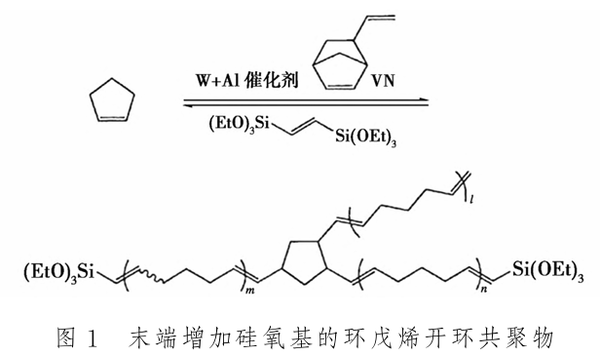
The cyclopentene ring-opening copolymer comprises a structure in which three cyclopentene ring-opening polymer chains are connected by branched structural units, where two of the cyclopentene ring-opening polymer chains are end-modified, while the remaining cyclopentene ring-opening polymer chain is unmodified at the end. Structural optimization has reduced the exothermicity of the synthesized product and improved its thermal flowability.
Patent WO20219/20823 discloses a structure unit containing norbornene compounds and monocyclic cyclic olefins, where the content ratio of the norbornene compound structure units exceeds 25%. This structural compound exhibits excellent mechanical strength, elongation properties, and resilience in the field of rubber.
Patent CN112368331 discloses a compound structure product generated from the polymerization of a preferred bicyclic [2.2.1] hept-2-ene compound with cyclopentene, where the ring-opening catalyst for the synthesized compound is selected from ruthenium carbene complexes such as bis(triphenylphosphine)-3,3-diphenylallylidene dichlororuthenium. Patent WO2020/19580 discloses polymers of the cis-1,3-cyclopentane structure (I) and trans-1,3-cyclopentane structure (II) (see Figure 2), where the preferred ring-opening synthesis catalysts are (phenylsulfonyl)(tetrachloride)(diethyl ether) tungsten, and bis{3,3',5,5'-tetramethyl-2,2'-biphenyl oxide} molybdenum oxide, while a co-catalyst is used alongside the main catalyst to complete the ring-opening reaction.
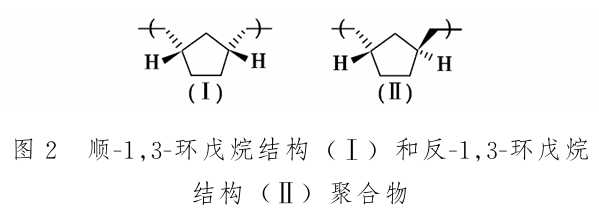
WO2020/21804 discloses an application for synthesizing optical films using COP materials, specifically by coating a layer of light-absorbing thermoplastic resin on the upper and lower surfaces of polycarbonate polymer. Patent WO2020/21806 forms a high-performance stretch film by covering it with thermoplastic resin.
WO2021/10704 discloses synthesis techniques for chiral naphthyl alicyclic compounds and their product performance, such as cycloolefin copolymers containing the exo-2-naphthyl norbornene structural unit (see Figure 3), which have good application prospects in the fields of optics and medicine.
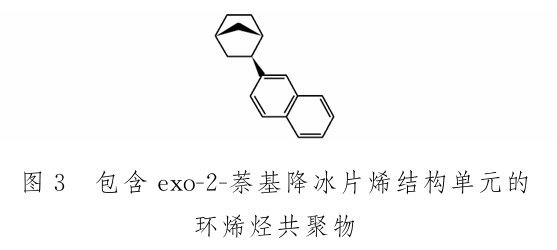
CN116867832A discloses a polymer containing 1-naphthyl norbornene structural units and 2-naphthyl norbornene structural units, which is generated by combining four types of monomers: bicyclo[2,2,1]hept-2-ene-5-(1-naphthyl)-exo, bicyclo[2,2,1]hept-2-ene-5-(2-naphthyl)-exo, bicyclo[2,2,1]hept-2-ene-5-(1-naphthyl)-endo, and bicyclo[2,2,1]hept-2-ene-5-(2-naphthyl)-endo, to improve product performance.
To enhance the degrees of freedom of optical lenses and other optical components, resins with high refractive index, high heat resistance, and low birefringence are required, but existing COC/COP cannot meet all these properties simultaneously. Japanese Zeon announced on October 12, 2023, in their patent "Cyclic Olefin Copolymer and Its Hydrogenated Product and Method for Producing Optical Element," that by polymerizing a mixture of 1-naphthyl norbornene and 2-naphthyl norbornene, they can achieve COC/COP that balances high refractive index, high heat resistance, and low birefringence. The refractive index can reach up to 1.609, and the COP glass transition temperature is above 135°C, significantly improving heat resistance.
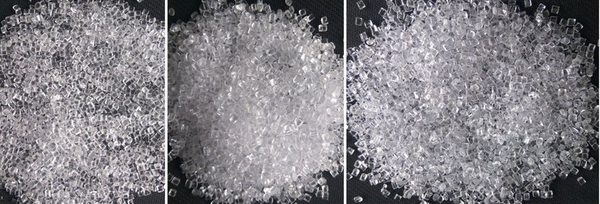
Japan Polyethylene Corporation
Japan Polypropylene Company provides low-temperature shrinkage, sealing, and high rigidity raw materials for a series of shrink films and sealing films in the consumer packaging industry by improving a new type of membrane extrusion-grade COC.
In the development of COC synthesis technology, Polyplastics has mainly focused on optimizing catalyst structures. For example, various catalyst structures are disclosed in patents WO2022070959, WO2022/024549, and JP7127231B, WO2020/204188, with titanium and zirconium metals being the most representative (see Figure 4).
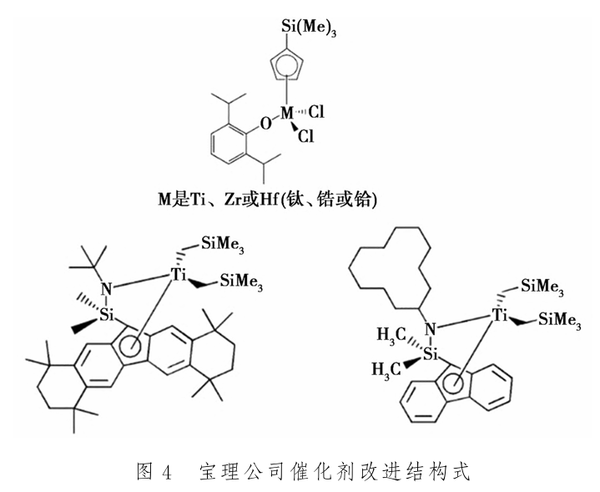
If a highly active catalyst is used for the polymerization of ethylene and norbornene monomers, it is likely to generate polyethylene impurities that affect the transparency of COC. Filtering and removing the insoluble polyethylene-like impurities will lead to increased manufacturing costs.
On March 3, 2023, Baoli released a patent titled "Method for Producing Cyclic Olefin Copolymers and Catalyst Compositions and Processes for Copolymerizing Norbornene Monomers with Ethylene." In this patent technology, when polymerizing norbornene monomers and ethylene monomers, a metal catalyst with nitrogen atoms bonded to group 4 transition metals and group 15 atoms of the periodic table is used, along with one of aluminum alkyls or borate compounds as a cocatalyst. This approach can suppress the generation of polyethylene-like impurities and improve the efficiency of COC copolymerization.
Mitsui Chemicals
Existing COC/COP have low solubility in solvents. On November 8, 2023, Mitsui Chemicals, Inc. published a patent titled "Method for Producing Norbornene-Based Copolymer, Norbornene-Based Copolymer Composition, and Molded Body," which develops a norbornene-based COC/COP with improved solvent solubility.
It is reported that COC/COP produced using this technology can dissolve in solvents such as methylcyclohexane and toluene, which are used for coating polymers at room temperature. Additionally, since a homogeneous solution of dissolved COC/COP can be obtained, the mechanical strength and elongation rate are excellent when forming films and other molded bodies. This makes it suitable for optical components, film packaging materials, optical films, or medical components.
In addition, COC/COP is prone to microcracks after high-temperature and high-humidity tests, which can reduce the optical properties of the molded products. To prevent the formation of microcracks, a hydrophilic stabilizer can be added to COC/COP. On November 3, 2023, Mitsui Chemicals, Inc. published a patent titled "Cyclic Olefin Resin Composition and Method for Producing Molded Articles," which addresses the issue of microcrack formation and mold contamination by using specific hydrophilic stabilizers along with glycerin or diglycerin with a molecular weight lower than that of the aforementioned hydrophilic stabilizers, and fatty acid monoesters and compounds.
Acoli Company
Acrylonitrile Corporation has innovated the synthesis process of COC materials by employing new catalysts and reaction conditions, enhancing the polymerization degree and molecular weight distribution uniformity of COC materials. At the same time, the company is further committed to developing COC materials with special functionalities, such as UV resistance and antibacterial properties.
In patent CN113354776A, Akerly improved the conditions for the addition copolymerization reaction of cyclic olefin monomers and α-olefins under the catalysis of catalysts and co-catalysts. The main catalysts selected are a series of compounds as shown in Figure 5, and the co-catalysts are selected from organic boron and organic aluminum compounds, such as B(C6F5)3 and triisobutylaluminum.
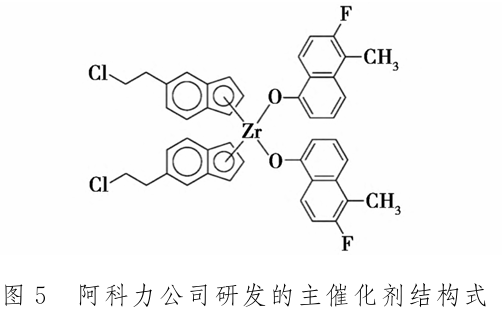
Patent CN113354775A discloses a titanium metal structure catalyst, with the structural formula shown in Figure 6.
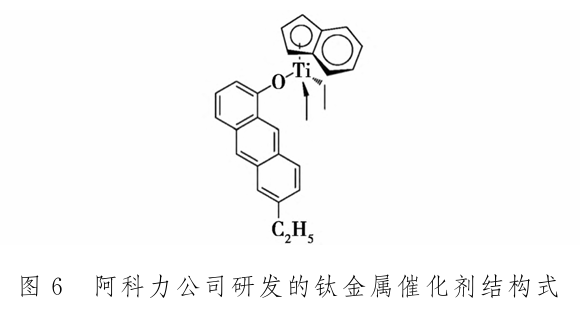
In patent CN115739007A, a metal ion adsorbent is prepared by reacting ultrafine coal powder, silane coupling agent, and dicarboxylic acid, which is used to adsorb metal residues produced during the process of cyclo-olefin copolymer (COC) production, thereby reducing the impurity content in COC products. Patent CN115779858A utilizes the reaction between activated carbon, unsaturated anhydride, unsaturated carboxylic acid, unsaturated sulfonic acid, and a cross-linking agent to prepare a metal adsorbent; patent CN115926047A obtains a de-metal complexing agent through the copolymerization of unsaturated anhydride, unsaturated acid, and unsaturated sulfonic acid, used for treating COC products to effectively remove residual metals from the polymer.
Patents CN5785443A, CN115850581B, and CN115850700A disclose the synthesis of different cycloolefin polymer products using chemical synthesis methods, with specific structural formulas as shown in Figure 7.
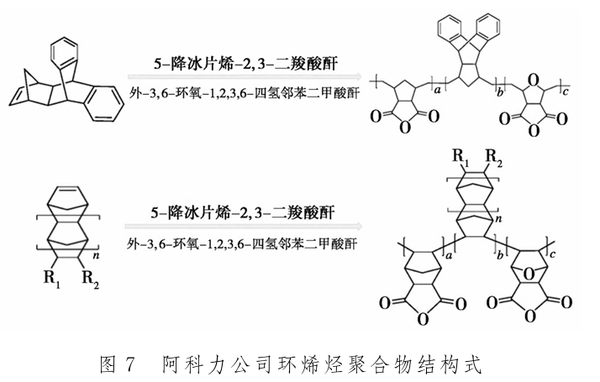
In addition, Aaokee Company is actively developing derivatives of cycloolefin polymers by modifying the surface of COC to create new materials. For example, by using dual modification with polydopamine and polysaccharide compounds (CN117304548A), the hydrophilicity of COC products can be increased. The specific process conditions are as follows: reacting dopamine hydrochloride on the surface of the cycloolefin copolymer film to form polydopamine, which tightly adheres to the film surface while introducing hydrophilic groups such as amino and hydroxyl groups; further connecting polysaccharide compounds to polydopamine achieves the hydrophilic modification of the surface of the cycloolefin copolymer film; immersing the cycloolefin copolymer film in a solution of 9-fluorenylmethyl ester derivative for treatment to obtain a hydrophilic cycloolefin copolymer film (CN117164927A); mixing dopamine hydrochloride with Tris-HCl buffer solution to prepare a cell-adhesive cycloolefin copolymer film (CN117304549A). The water contact angle of this film's surface decreases from an original 100° to 70°, while its cell adhesion effect significantly increases.
Topchem Technology
TuoXian Technology has already established a 3,000吨/年 COC/COP production line, and simultaneously plans to expand by an additional 7,000 tons/year. Once completed, the total capacity will reach 10,000 tons/year. Note: The term "吨/年" has been translated as "tons/year" assuming it refers to metric tons per year. If it refers to a different unit or if another conversion is needed, please clarify.
Patent CN113788862A proposes a bis-metallocene compound used for synthesizing COC and screens the optimized bis-metallocene catalyst as rac-dimethylsilyl bis(1-indene) dichlorozirconium. Patent CN219441667U improves the production device by setting an auxiliary stirring component on the main stirring element in the main cavity of the polymerization reaction kettle, solving the problem of insufficient stirring during the reaction process.
Based on the analysis of patents in the cycloolefin + medical field between China and Japan from 2020 to 2024, the preliminary findings are as follows:
Research focus of the Chinese R&D team
Cycloolefin Copolymers and Their Preparation Methods
Focus on the selection and design of monomers, choice and optimization of catalysts, control of polymerization reaction conditions, and regulation of the structure and properties of copolymers. For example: Pay attention to the development of new catalysts, such as metallocene catalysts, ruthenium carbene catalysts, etc., as well as the regulation of properties such as molecular weight, molecular weight distribution, glass transition temperature, refractive index, hydrophilicity, etc. of copolymers.
Prefilled Syringe with Polymer Barrel
Focus on the selection and optimization of syringe barrel materials, the development and matching of sealing piston materials, the improvement of syringe sealing and drug shelf life performance, and the evaluation of syringe biocompatibility and pharmaceutical compatibility. For example, research on the application of cyclic olefin copolymers, cyclic olefin polymers, and their modified materials in syringe barrels, as well as the application of thermoplastic elastomers and silicone rubber curing agents in sealing piston materials.
Transparent toughened ring-opening metathesis copolymer
Focus on the selection and ratio optimization of copolymer components, the balance between transparency and toughness of copolymers, and the expansion of copolymer applications in the medical materials field. For example, by adding toughening agents, compatibilizers, antioxidants, lubricants, and other components, improve the transparency and toughness of cyclic olefin copolymers to meet the requirements of medical materials.
Research Focus of the Japanese Development Team
Resin Composition and Molded Article
Focus on dielectric properties, elongation, flexibility, heat resistance, impact resistance, and molding processability, etc. For example: Research on resin compositions based on cyclic olefins aims to achieve a balance of dielectric properties, elongation, and flexibility, as well as to develop resin compositions with high heat resistance and good molding processability.
Medical Device Materials
Focus on biocompatibility, gamma ray irradiation resistance, impact resistance, transparency, etc. For example: Develop cyclo olefin copolymer compositions and molded products for medical devices, focusing on their glass transition temperature, gamma ray irradiation resistance, and impact resistance.
Packaging Materials
Focus on barrier properties, sealing strength, impact resistance, tearability, optical properties, etc. For example: study the compositions in laminated films, packaging bags, and pouches, paying attention to their barrier properties, sealing strength, and tearability.
Analysis of the Differences in Cycloolefin R&D Between Two Countries During the Same Period
Research focuses are different.
Chinese research teams focus more on innovations in cycloolefin copolymers and their preparation methods, as well as the development and application of specific products such as high molecular weight prefilled syringes and transparent toughened cycloolefin copolymers.
The research and development teams in Japan focus more on the development of basic materials such as optical materials, resin compositions and molded products, adhesives, and coatings, as well as their applications in areas like electronic devices, medical equipment, and packaging materials.
Different technical paths
Chinese research teams focus on the development of new catalysts and optimization of polymerization conditions in the preparation of cycloolefin copolymers to enhance the properties of the copolymers.
The Japanese research and development teams focus more on the performance modulation and application development of materials, such as achieving specific optical, electrical, and mechanical properties by adjusting the composition and structure of the materials to meet the needs of different fields.
Different market orientations
The research and development activities of the Chinese R&D team in the field of cyclic olefins and medical applications are more closely aligned with market demands, focusing on product application expansion and commercialization processes.
The research and development teams in Japan focus more on basic research and the development of innovative technologies to promote technological advancements and application expansions in the entire field.
【Copyright and Disclaimer】The above information is collected and organized by PlastMatch. The copyright belongs to the original author. This article is reprinted for the purpose of providing more information, and it does not imply that PlastMatch endorses the views expressed in the article or guarantees its accuracy. If there are any errors in the source attribution or if your legitimate rights have been infringed, please contact us, and we will promptly correct or remove the content. If other media, websites, or individuals use the aforementioned content, they must clearly indicate the original source and origin of the work and assume legal responsibility on their own.
Most Popular
-

List Released! Mexico Announces 50% Tariff On 1,371 China Product Categories
-

Nissan Cuts Production of New Leaf EV in Half Due to Battery Shortage
-

New Breakthrough in Domestic Adiponitrile! Observing the Rise of China's Nylon Industry Chain from Tianchen Qixiang's Production
-

Dow, Wanhua, Huntsman Intensively Raise Prices! Who Controls the Global MDI Prices?
-

Mexico officially imposes tariffs on 1,400 chinese products, with rates up to 50%






